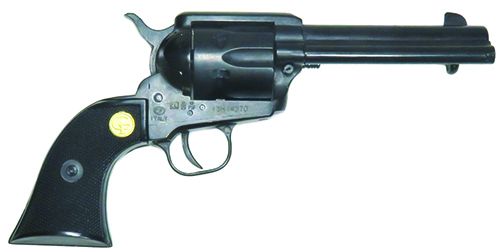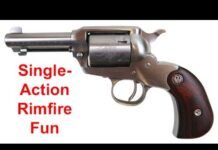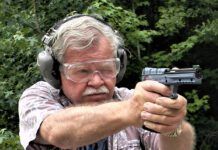GUN TESTS GRADE: B
$172
This was a pre-shutdown price at BudsGunShop.com. The Cimarron Plinkerton is inexpensive and looked it. This model is actually discontinued by Cimarron, but it is available from Chiappa Firearms. The Plinkerton and the Chiappa 1873 SAA 22 are virtually the same revolver. Both are manufactured by Chiappa in Italy. The barrel and fluted cylinder were made of steel. The frame, one-piece grip frame, and barrel sleeve were made of Zamak alloy, which is a combination of zinc and aluminum. The finish on the cylinder did not match the finish on the rest of the revolver. The finish looked thin.
| Action | Revolver, single action |
| Overall Length | 10.0 in. |
| Overall Height | 5.25 in. |
| Maximum Width | 1.6 in. |
| Weight Unloaded | 33.0 oz. |
| Weight Loaded | 36.6 oz. |
| Cylinder Gap | 0.008 in. |
| Barrel Length | 4.75 in. |
| Capacity | 6 |
| Frame Material/Finish | Zamak alloy/matte black |
| Cylinder Material/Finish | Steel/matte black |
| Frame Front Strap Height | 2.1 in. |
| Frame Back Strap Height | 3.0 in. |
| Grips | Checkered plastic |
| Grip Thickness (max) | 1.5 in. |
| Grip Circumference (max) | 5.7 in. |
| Front Sight | Ramp blade |
| Rear Sight | Fixed notch |
| Sight Radius | 5.5 in. |
| Trigger-Pull Weight | 2.5 lbs. |
| Trigger Span | 2.8 in. |
| Safety | Key-activated gun lock |
| Warranty | 1 year |
| Telephone | (877) 749-4861 |
| Website | Cimarron-Firearms.com |
| Made In | Italy |
Another complaint were the two-piece grips. They were well fitted to the grip strap, but the area where the grip and the frame met was sloppy. The plastic grip panels protruded above the surface of the frame about 0.125 inches, and because this is the area where the user grips the revolver, it can rub the skin during recoil. Albeit the recoil isn’t much with a 22 LR, but the repetition of extended shooting can wear on the user’s trigger finger. Besides those two well-deserved gripes, the Plinkerton has nice heft and is similar in weight to a centerfire revolver. In fact it looks like a standard six-shooter. The grip was slightly smaller than a traditional centerfire. We thought the grip worked fine except for the aforementioned grip panels. The action had three distinct clicks when the shooter thumbed back the hammer. The hammer needs to be on half cock to rotate the cylinder to load or unload. The loading gate was sized for a centerfire cartridge, so there was plenty of room to load the tiny 22 LR cartridges in one of the six chambers. The chambers were not countersunk. Because the cylinder is designed for a longer centerfire cartridge, the 22 LR bullets need to leap about 0.7 inches before entering the forcing cone. We expected some splatter, but did not experience any during live fire. The firing pin is fixed into the frame, and there is no transfer bar. Do not carry this revolver with a live round chambered under the hammer and firing pin. The hammer at full cock came back quite far. A large-handed user might get the web of his hand pinched between the hammer and backstrap, but we had no issues. The hammer had good checkering on the spur, but the edge was a bit sharp. We’d take a file to this if we owned the gun and refinish the repair with a black Sharpie pen. The hammer was easy to cock, and the cylinder indexed and rotated like a traditional centerfire six-shooter. While the Plinkerton operated similar to a traditional SAA, it did have a unique safety lock that blocks the hammer from contacting the firing pin. A key is required to rotate the safety in place. When locked, the revolver can be loaded and unloaded and the hammer snapped, but it will not contact the firing pin. You might want to use this lock when storing the revolver. Also similar to a traditional single action is the skinny trigger. It had creep before it broke at 2.5 pounds, on average. We liked the pull weight and know that it contributed to our accuracy data results. The ejector rod head was a traditional crescent-shaped piece and rotated away from the barrel so your finger doesn’t get scorched when reloading after extending firing. The sights consisted of a blade front and a notch in the top strap of the frame. To field-strip the Plinkerton, place the hammer on half cock, open the loading gate, and push the base pin button while pulling out the cylinder rod. The cylinder then falls out of the loading gate side of the frame. The cylinder had a removable bushing like a traditional centerfire single action. At the range we started thumbing and squeezing with inexpensive 40-grain Remington Thunderbolt ammo, and we were rewarded with a best five-shot group that measured 0.8 inches. The best groups became progressively smaller with the 40-grain PMC Target ammo (0.72 inches), and the 36-grain CCI Mini-Mags (0.70 inches). On average, all ammo grouped under an inch. That’s the good news. The bad news is the Plinkerton shot low and to the left. We needed to use some Kentucky windage and elevation to center our shots on the target. You could take a file to the front blade to adjust the elevation, and for the windage bend the blade. Our fear is the the Plinkerton’s die-cast metal could be brittle and easily break, and we wouldn’t do it. Don’t blame us if you break your sight. The shot load gave us an 11-inch off-center pattern at 10 yards. When unloading, we needed to use the ejector rod on all chambers. The dry lubricant on 22 LR bullets gunk up the chambers, so the cases do not fall free. The cylinder had plenty of back-and-forth rotation, and we looked at the front of cylinder to line up the ejector rod with the front of the chamber. We noticed the ejector rod housing was not exactly flush with the side of the barrel. We could see light between the barrel and housing.
Our Team Said: The Plinkerton was fun to shoot and offered all we expected in a rimfire single-action revolver. We did not care for the rough-fitting grip panels and thin-looking finish. We also did not like that it did not shoot to point of aim, but it was accurate. The price was reasonable, but in this case, you get what you pay for.
Special thanks to Eastern Outfitters (EasternOutfitter.com) of Hampstead, NC, for their assistance. Written and photographed by Robert Sadowski, using evaluations from Gun Tests
team testers




























